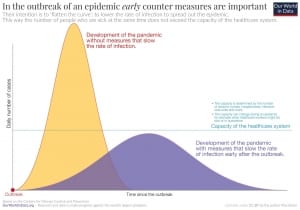ICU physician Dr. Daniele Macchini in Bergamo, Italy (March 9, 2020): “The media in Europe are reassuring, politicians are reassuring, while there’s little to be reassured of”
*
Updates
I will post the most recent update first:
A Nov. 29, 2020 New York Times article is entitled: ‘The lost days that made Bergamo a coronavirus tragedy.”
An excerpt reads:
For days, there was an expectation that the national government would lock down towns in Bergamo, as it had earlier done immediately and decisively in Lodi. Some mayors in Bergamo waited anxiously for the police to seal the borders, even as many business and local leaders expressed reluctance.
Italy’s prime minister, Giuseppe Conte, publicly turned to a committee of scientific advisers, which formally proposed that he follow the example of Lodi and shut down the newly infected towns in Bergamo. Privately, though, national business lobbies urged him not to close the area’s factories.
Ultimately, after critical days filled with bureaucratic dithering, as well as spats between Rome and the regional authorities, the government decided the time to save Bergamo had passed.
April 7, 2020 Journalist’s Resource article
An April 7, 2020 Journalist’s Resource article is entitled: “Social distancing time frames: How our expectations affect compliance.”
An excerpt reads:
In a new National Bureau of Economic Research working paper, researchers surveyed nearly 900 Italian residents to explore what happens when expectations are shattered about how long social distancing measures, like self-isolation, would last. Participants were less willing to do more self-isolating when told that social distancing time frames would run much longer or shorter than they anticipated.
“In a context where individual compliance has collective benefits, but full enforcement is costly and controversial, communication and persuasion have a fundamental role,” the authors write.
The working paper to which the article refers includes a note that reads:
NBER working papers are circulated for discussion and comment purposes. They have not been peer-reviewed or been subject to the review by the NBER Board of Directors that accompanies official NBER publications.
An April 8, 2020 New York Magazine article is entitled: “Losing Hope in the ICU ‘I don’t know how long I can keep doing this for.'”
An April 5, 2020 New York Times interactive article, which is highly informative, is entitled: “Italy’s virus shutdown came too late. What happens now?”
An excerpt reads:
Some scientists say that Italian officials did not act decisively to stop the virus early on, underestimating its danger and how quickly it spreads. “We realized the virus was here too late,” said Roberto Burioni, one of Italy’s leading virologists. “It was already spreading.”
Any decision to let up now and ease restrictions on movement, public health officials warned, would risk a new wave of infections. “We haven’t reached the peak, and we haven’t passed it,” Silvio Brusaferro, the head of Italy’s national health institute, said at a recent news conference.
A March 12, 2020 New York Times article is entitled: “How the World’s Largest Coronavirus Outbreaks Are Growing.”
An excerpt reads:
“Today, the red zone is Italy,” Matteo Renzi, a former prime minister, told The New York Times. But in 10 days, he warned, it will be Madrid, Paris and Berlin. If Italy cannot show how to stop the virus, he said, “the red zone will be Europe.”

The image courtesy of OurWorldInData.org is from a March 11, 2020 tweet from Greta Thunberg, who notes: “We can’t solve a crisis without treating it as a crisis and we must unite behind experts and science. This of course goes for all crises. Now the experts urge us to avoid big public gatherings for a better chance to #flattenthecurve and slow the spreading of the Coronavirus. 1/4”
Useful resource (New England Complex Systems Institute):
Stopping the Coronavirus Epidemic
Additional valuable resource (EndCoronavirus.org):
Early Outbreak Response Guidelines
The above-noted site includes a PDF entitled:
COVID-19 Recommendations for Policy Makers
[End of updates]
*
A given person’s age and health status will influence how they view news reports and information related to the new coronavirus.
A previous post is entitled:
For those nervous about COVID-19, check out these resources
Regarding the emerging situation, Judy Trinh @judyatrinh has tweeted the following thread which I found was of much interest.

Dr. Daniele Macchini, Bergamo, Italy. Source: March 8, 2020 ecodibergamo.it post entitled: «Con le nostre azioni influenziamo la vita e la morte di molte persone»
She notes: “An Italian doctor describes the toll coronavirus is taking on Italy’s hospital system.”
Here is the thread:
Silvia Stringhini @silviast9 March 9, 2020
I may be repeating myself, but I want to fight this sense of security that I see outside of the epicenters, as if nothing was going to happen “here”. The media in Europe are reassuring, politicians are reassuring, while there’s little to be reassured of. #COVID19 #coronavirus
This is the English translation of a post of another ICU physician in Bergamo, Dr. Daniele Macchini.
After much thought about whether and what to write about what is happening to us, I felt that silence was not responsible.
I will therefore try to convey to people far from our reality what we are living in Bergamo in these days of Covid-19 pandemic. I understand the need not to create panic, but when the message of the dangerousness of what is happening does not reach people I shudder.
I myself watched with some amazement the reorganization of the entire hospital in the past week, when our current enemy was still in the shadows: the wards slowly “emptied”, elective activities were interrupted, intensive care were freed up to create as many beds as possible.
All this rapid transformation brought an atmosphere of silence and surreal emptiness to the corridors of the hospital that we did not yet understand, waiting for a war that was yet to begin and that many (including me) were not so sure would ever come with such ferocity.
I still remember my night call a week ago when I was waiting for the results of a swab. When I think about it, my anxiety over one possible case seems almost ridiculous and unjustified, now that I’ve seen what’s happening. Well, the situation now is dramatic to say the least.
The war has literally exploded and battles are uninterrupted day and night. But now that need for beds has arrived in all its drama. One after the other the departments that had been emptied fill up at an impressive pace.
The boards with the names of the patients, of different colours depending on the operating unit, are now all red and instead of surgery you see the diagnosis, which is always the damned same: bilateral interstitial pneumonia.
Now, explain to me which flu virus causes such a rapid drama. [Post continues comparing covid19 to flu… ] And while there are still people who boast of not being afraid by ignoring directions, protesting because their normal routine is “temporarily” put in crisis, the epidemiological disaster is taking place. And there are no more surgeons, urologists, orthopedists, we are only doctors who suddenly become part of a single team to face this tsunami that has overwhelmed us.
Cases are multiplying, we arrive at a rate of 15-20 admissions per day all for the same reason. The results of the swabs now come one after the other: positive, positive, positive. Suddenly the E.R. is collapsing.
Reasons for the access always the same: fever and breathing difficulties, fever and cough, respiratory failure. Radiology reports always the same: bilateral interstitial pneumonia, bilateral interstitial pneumonia, bilateral interstitial pneumonia. All to be hospitalized.
Someone already to be intubated and go to intensive care. For others it’s too late… Every ventilator becomes like gold: those in operating theatres that have now suspended their non-urgent activity become intensive care places that did not exist before.
The staff is exhausted. I saw the tiredness on faces that didn’t know what it was despite the already exhausting workloads they had. I saw a solidarity of all of us, who never failed to go to our internist colleagues to ask “what can I do for you now?”
Doctors who move beds and transfer patients, who administer therapies instead of nurses. Nurses with tears in their eyes because we can’t save everyone, and the vital parameters of several patients at the same time reveal an already marked destiny.
There are no more shifts, no more hours. Social life is suspended for us. We no longer see our families for fear of infecting them. Some of us have already become infected despite the protocols.
Some of our colleagues who are infected also have infected relatives and some of their relatives are already struggling between life and death. So be patient, you can’t go to the theatre, museums or the gym. Try to have pity on the myriad of old people you could exterminate.
We just try to make ourselves useful. You should do the same: we influence the life and death of a few dozen people. You with yours, many more. Please share this message. We must spread the word to prevent what is happening here from happening all over Italy.
I finish by saying that I really don’t understand this war on panic. The only reason I see is mask shortages, but there’s no mask on sale anymore. We don’t have a lot of studies, but is it panic really worse than neglect and carelessness during an epidemic of this sort?
Full post here:
«Con le nostre azioni influenziamo la vita e la morte di molte persone»
Con un lungo post su Facebook, il dottor Daniele Macchini, medico dell’Humanitas Gavazzeni, racconta la sua vita in prima linea per contrastare il coronavirus. È una testimonianza da brividi, da… ecodibergamo.it
Related news reports
Some countries – given their histories and current health systems and capabilities – are addressing the emerging situation better than others. Below are links that may provide a glimpse regarding how events may unfold in weeks ahead.
March 3, 2020 Stanford Health Policy article: Taiwan gets it right
A March 3, 2020 Stanford Health Policy article is entitled: “How Taiwan Used Big Data, Transparency and a Central Command to Protect Its People from Coronavirus.”
A related March 3, 2020 Journal of the American Medical Association Network viewpoint article is entitled: “Response to COVID-19 in Taiwan: Big Data Analytics, New Technology, and Proactive Testing.” [The site uses cookies.]
An excerpt reads:
COVID-19 occurred just before the Lunar New Year during which time millions of Chinese and Taiwanese were expected to travel for the holidays. Taiwan quickly mobilized and instituted specific approaches for case identification, containment, and resource allocation to protect the public health. Taiwan leveraged its national health insurance database and integrated it with its immigration and customs database to begin the creation of big data for analytics; it generated real-time alerts during a clinical visit based on travel history and clinical symptoms to aid case identification. It also used new technology, including QR code scanning and online reporting of travel history and health symptoms to classify travelers’ infectious risks based on flight origin and travel history in the past 14 days. Persons with low risk (no travel to level 3 alert areas) were sent a health declaration border pass via SMS (short message service) messaging to their phones for faster immigration clearance; those with higher risk (recent travel to level 3 alert areas) were quarantined at home and tracked through their mobile phone to ensure that they remained at home during the incubation period.
March 9, 2020 Time article: US not ready
A March 9, 2020 Time article is entitled: “The Trump Administration Is Stalling an Intel Report That Warns the U.S. Isn’t Ready for a Global Pandemic.”
An excerpt reads:
The final draft of the report remains classified but the two officials who have read it say it contains warnings similar to those in the last installment, which was published on January 29, 2019. The 2019 report warns on page 29 that, “The United States will remain vulnerable to the next flu pandemic or large-scale outbreak of a contagious disease that could lead to massive rates of death and disability, severely affect the world economy, strain international resources, and increase calls on the United States for support.”
March 9, 2020 Associated Press article: Rapid testing ensures few deaths in Germany
A March 9, 2020 Associated Press article is entitled: “Experts: Rapid testing helps explain few German virus deaths.”
An excerpt reads:
Germany has confirmed more than 1,100 cases of the new coronavirus but — so far — just two deaths, far fewer than other European countries with a similar number of reported infections.
Experts said Monday that rapid testing as the outbreak unfolded meant Germany has probably diagnosed a much larger proportion of those who have been infected, including younger patients who are less likely to develop serious complications.
That’s given authorities more chance of containing the virus, and more time to prepare for it.
March 9, 2020 Reuters article: Ontario stockpile of face masks has expired
A March 9, 2020 Reuters article is entitled: “Exclusive: Millions of masks stockpiled in Canada’s Ontario expired before coronavirus hit.”
An excerpt reads:
Millions of face masks stockpiled by Ontario in the aftermath of the SARS outbreak to protect healthcare workers during a future epidemic have expired, according to provincial officials and documents, raising questions about the readiness of Canada’s most populous province to deal with the spreading coronavirus.
March 10, 2020 Guardian article: Dramatic lack of US preparedness
A March 10, 2020 Guardian article is entitled: “Shifting guidelines on coronavirus treatment in US could be ‘catastrophic’: Healthcare workers fighting the outbreak are struggling with a dramatic lack of preparedness and a lack of steady guidance.”
An excerpt reads:
“We are starting to see all the hospitals get in line to undermine the precautions that should be in place,” said David Pratt, a New York State Nurses Association health and safety representative, explaining the growing pushback against inconsistent information. “There are different things being said.”
Pratt claimed that a whistleblower told his organization that healthcare employers were pushing the federal public health agency, the Centers for Disease Control and Prevention (CDC), to loosen protection guidelines – which, in turn, would change them.
“It’s not just coronavirus, but a virus that can spread through contact as well as through droplets,” Pratt said. “Employers have been pushing to get the CDC to back off on the requirement that, for example, the nurses and other staff use N95 respirators.”
March 10, 2020 Atlantic article: Social distancing is only option
A March 10, 2020 Atlantic article is entitled: “Cancel Everything: Social distancing is the only way to stop the coronavirus. We must start immediately.”
We don’t yet know the full ramifications of the novel coronavirus. But three crucial facts have become clear in the first months of this extraordinary global event. And what they add up to is not an invocation to stay calm, as so many politicians around the globe are incessantly suggesting; it is, on the contrary, the case for changing our behavior in radical ways – right now.”
March 10, 2020 CBC article: Need to protect most vulnerable
A March 10, 2020 CBC article is entitled: “Canada’s first COVID-19 death is not cause for panic — but shows need to protect most vulnerable: An estimated 80% of those infected with COVID-19 will have mild symptoms, according to the WHO.”
An excerpt reads:
Gardam, a veteran of SARS and H1N1 who is watching this outbreak closely, says while that panic is ill-advised, Canadians do need to be aware of what’s happening with COVID-19 worldwide.
“I think Canada has been living in a bubble the last two months thinking that this is something that’s happening elsewhere,” he said.
“We’re just at the beginning of now, this starting to really happen here. This isn’t the last death we’re going to hear about from this virus.”




Leave a Reply
Want to join the discussion?Feel free to contribute!